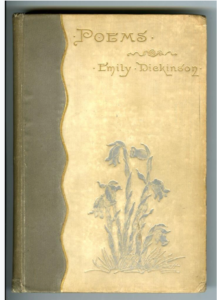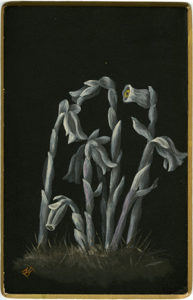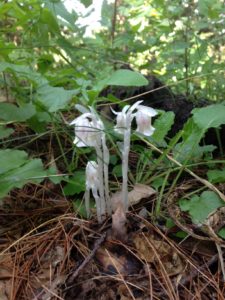10/6/18
On this day in 1882, Mabel Loomis Todd recorded the following entry in her diary:
“This letter made me happier than almost any other I have ever received. It fairly thrilled me, which shows that my susceptibility to magnetic friendships is not entirely confined to men, as I have occasionally thought myself.”
The letter to which she referred came from none other than Emily Dickinson. Mabel was so taken with Emily’s letter that she copied it, word for word, into her journal, as well as writing about it in her diary.
Emily’s letter to Mabel thanked her for a painting Mabel had created and sent upstairs to the reclusive poet during a recent visit to The Homestead. Mabel’s painting was of Indian Pipe wildflowers. This ethereal looking wildflower is also known as “the ghost plant” or the “corpse plant.” It contains no chlorophyll and because it does not depend on sunlight to grow, can flourish in dark, forested places. It’s more like a mushroom than a traditional wildflower, appearing suddenly and unpredictably. Its white countenance is striking. And it only lasts for a few days.
“That without suspecting it you should send me the preferred flower of life, seems almost supernatural, and the sweet glee that I felt at meeting it, I could confide to none,” Emily wrote.

Of course Emily Dickinson, who cultivated flowers and studied them meticulously, would have greatly appreciated Mabel’s efforts to capture the ephemeral “ghost plant.” “I had pondered for a long time to send her a painting of something,” Mabel wrote in her journal, “but when I came back I looked over my studies and by a sudden inspiration I determined to paint the Indian pipes on a black panel for her.”
In Emily’s response, Mabel knew that she had hit the mark in her choice of subject:
“To duplicate the vision is almost more amazing, for God’s unique capacity is too surprising to surprise. I know not how to thank you—We do not thank the rainbow, although its twoplay is a snare.
To give delight is hallowed—perhaps the toil of angels whose avocations are concealed.”
It’s not surprising that, years later, Mabel chose her panel of Indian Pipe wildflowers to grace the cover of the first published volume of Emily’s poetry. For Mabel, this was a symbol not only of the poet whose poetry had long been hidden from the world and would only then sprout up like the Indian Pipes, but also a symbol of the bond she felt she’d made with the poet whom she’d never actually met. Knowing this, years later Millicent also decided that the most appropriate symbol to have etched on her mother’s headstone was…the Indian Pipes
Interesting – and weirdly – right after I had received the first proofs of After Emily from W.W. Norton, I was out walking my dog and saw something I’d never before seen in the woods in front of the home where I’ve lived for three decades: Indian Pipe wildflowers. I snapped a photo on my phone because I could hardly believe what I’d seen!


